Effective suppression of human immunodeficiency virus type 1 through a combination of short- or long-hairpin RNAs targeting essential sequences for retroviral integration
- PMID: 16840344
- PMCID: PMC1563699
- DOI: 10.1128/JVI.00078-06
Effective suppression of human immunodeficiency virus type 1 through a combination of short- or long-hairpin RNAs targeting essential sequences for retroviral integration
Abstract
Small interfering RNA (siRNA) could provide a new therapeutic approach to treating human immunodeficiency virus type 1 (HIV-1) infection. For long-term suppression of HIV-1, emergence of siRNA escape variants must be controlled. Here, we constructed lentiviral vectors encoding short-hairpin RNAs (shRNA) corresponding to conserved target sequences within the integrase (int) and the attachment site (att) genes, both of which are essential for HIV-1 integration. Compared to shRNA targeting of the HIV-1 transcription factor tat (shTat), shRNA against int (shIN) or the U3 region of att (shU3) showed a more potent inhibitory effect on HIV-1 replication in human CD4+ T cells. Infection with a high dose of HIV-1 resulted in the emergence of escape mutants during long-term culture. Of note, limited genetic variation was observed in the viruses resistant to shIN. A combination of shINs against wild-type and escape mutant sequences had a negative effect on their antiviral activities, indicating a potentially detrimental effect when administering multiple shRNA targeting the same region to combat HIV-1 variants. The combination of shIN and shU3 att exhibited the strongest anti-HIV-1 activity, as seen by complete abrogation of viral DNA synthesis and viral integration. In addition, a modified long-hairpin RNA spanning the 50 nucleotides in the shIN target region effectively suppressed wild-type and shIN-resistant mutant HIV-1. These results suggest that targeting of incoming viral RNA before proviral DNA formation occurs through the use of nonoverlapping multiple siRNAs is a potent approach to achieving sustained, efficient suppression of highly mutable viruses, such as HIV-1.
Figures
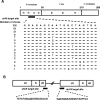
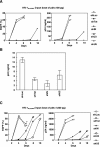
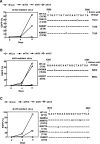
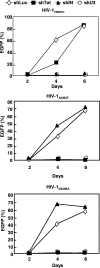

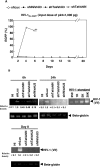
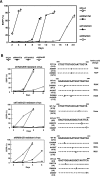
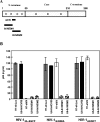
Similar articles
-
Lentiviral siRNAs targeting multiple highly conserved RNA sequences of human immunodeficiency virus type 1.Gene Ther. 2005 Jul;12(14):1133-44. doi: 10.1038/sj.gt.3302509. Gene Ther. 2005. PMID: 15750613
-
Trans-inhibition of HIV-1 by a long hairpin RNA expressed within the viral genome.Retrovirology. 2007 Mar 1;4:15. doi: 10.1186/1742-4690-4-15. Retrovirology. 2007. PMID: 17331227 Free PMC article.
-
Human immunodeficiency virus type 1 escape from RNA interference.J Virol. 2003 Nov;77(21):11531-5. doi: 10.1128/jvi.77.21.11531-11535.2003. J Virol. 2003. PMID: 14557638 Free PMC article.
-
Anti-HIV-1 gene expressing lentiviral vectors as an adjunctive therapy for HIV-1 infection.Curr HIV Res. 2004 Apr;2(2):185-91. doi: 10.2174/1570162043484906. Curr HIV Res. 2004. PMID: 15078182 Review.
-
RNAi in combination with a ribozyme and TAR decoy for treatment of HIV infection in hematopoietic cell gene therapy.Ann N Y Acad Sci. 2006 Oct;1082:172-9. doi: 10.1196/annals.1348.006. Ann N Y Acad Sci. 2006. PMID: 17145937 Review.
Cited by
-
RNA Viruses and RNAi: Quasispecies Implications for Viral Escape.Viruses. 2015 Jun 19;7(6):3226-40. doi: 10.3390/v7062768. Viruses. 2015. PMID: 26102581 Free PMC article. Review.
-
Two approaches to construct mammalian expression vector of shRNA to reduce expression and replication of HBV in vitro.Mol Biol Rep. 2008 Sep;35(3):465-72. doi: 10.1007/s11033-007-9108-0. Epub 2007 Jun 22. Mol Biol Rep. 2008. PMID: 17588164
-
Small interfering RNA (siRNA)-based therapeutic applications against viruses: principles, potential, and challenges.J Biomed Sci. 2023 Oct 16;30(1):88. doi: 10.1186/s12929-023-00981-9. J Biomed Sci. 2023. PMID: 37845731 Free PMC article. Review.
-
Design of peptide-based inhibitors for human immunodeficiency virus type 1 strains resistant to T-20.J Biol Chem. 2009 Feb 20;284(8):4914-20. doi: 10.1074/jbc.M807169200. Epub 2008 Dec 10. J Biol Chem. 2009. PMID: 19073606 Free PMC article.
-
The therapeutic landscape of HIV-1 via genome editing.AIDS Res Ther. 2017 Jul 14;14(1):32. doi: 10.1186/s12981-017-0157-8. AIDS Res Ther. 2017. PMID: 28705213 Free PMC article. Review.
References
-
- Banerjea, A., M. J. Li, G. Bauer, L. Remling, N. S. Lee, J. Rossi, and R. Akkina. 2003. Inhibition of HIV-1 by lentiviral vector-transduced siRNAs in T lymphocytes differentiated in SCID-hu mice and CD34+ progenitor cell-derived macrophages. Mol. Ther. 8:62-71. - PubMed
-
- Bennasser, Y., S. Y. Le, M. Benkirane, and K. T. Jeang. 2005. Evidence that HIV-1 encodes an siRNA and a suppressor of RNA silencing. Immunity 22:607-619. - PubMed
Publication types
MeSH terms
Substances
LinkOut - more resources
Full Text Sources
Other Literature Sources
Research Materials

